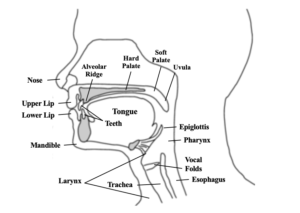The American R
The American R
The American R is the hardest sound to produce for both native and nonnative speakers. Developmentally, it is the last sound to emerge and is not expected to be mastered until the age of 8. For comparison, the earliest sounds to develop, such as /p, b, m/ emerge by age 3.
Some languages don’t have the R sound, or it is produced as flapped, with the tongue tip behind the alveolar ridge like a /d/ sound or trilled, like the rolled ‘R’ in Spanish.
The main reason the American R is so difficult is that there are no oral landmarks. With other sounds, the articulators (lips, teeth, jaw, tongue, etc.) are touching somewhere in the mouth. For example, for the /p/ sound, both lips touch. For the /s/ sound, the tip of the tongue touches behind the top teeth (some people produce /s/ with their tongue tip down).

How to Produce the American R
So, how do you produce this difficult sound? There are two ways. The most common way is called the Retroflex R. Think of the tongue shaped like a mountain, with the tongue tip curled up and backward like a ‘C.’

The other way is called the Bunched R. The tongue is pulled back, or bunched up, with the sides close to the top teeth.

Vocalic R
Another reason the American R is so difficult is that it is colored by vowels. The vocalic /ɹ/, which refers to any /ɹ/ that follows a vowel, like -er and -air, takes on vocalic properties depending on what vowel comes before it.
Typically -er, as in ‘earth,’ is the most difficult, especially the blend –erl as in ‘girl, world.’ So, this means there are many types of /ɹ/ productions to learn.
The Jaw and Tongue
In addition to tongue placement (retroflex vs. bunched R), jaw height and tongue tension play a huge role in the production of this sound.
I have my clients play around with jaw height- either opening their jaw wider or closing their jaw more. This naturally gives the tongue more or less room to move into position. For clients who speak a native language that uses a trilled or flapped R, having them open their jaw wide will prevent them from being able to touch their tongue to the roof of the mouth and produce a /d/ sound.
Clients whose native language doesn’t use R at all in their phonological sound inventory will tend to substitute a /w/ for /r/. They need a reminder to ‘squeeze their tongue’ in order to add more lingual tension.
What techniques do you use to teach the American R? What words with R are the most challenging? Let us know in the comments below.

One Comment